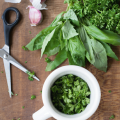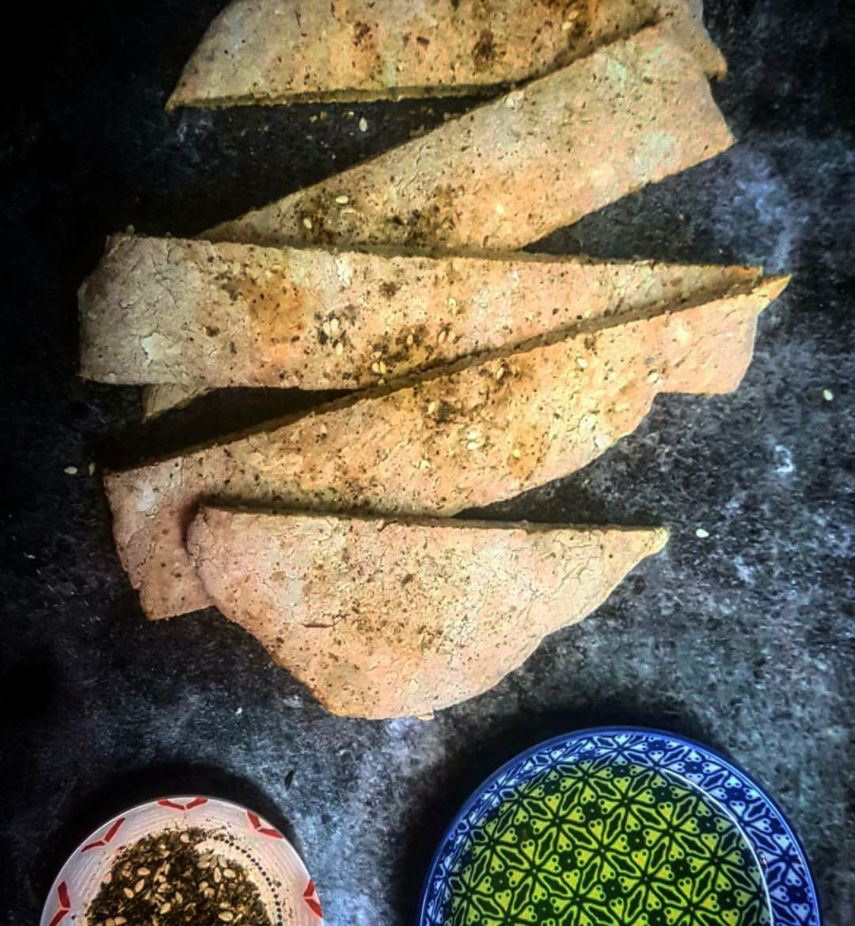Tw*tbreads, 4p [VG/V/DF*]
I joke that ninety-seven percent of the spontaneous conversations that my friends start with me – especially mid afternoon or early in the evening – are panicked cookery conundrums, photographs of burned pans, musings about what to have for dinner based on photographs of their kitchen cupboards, or emergency cake queries. This afternoon was no exception.
It started off innocently enough, as a dear friend sent a photograph of my tomatoey baba ghanoush recipe, announcing she was going to attempt to make it. This, you understand, is code for ‘please put your phone notifications on LOUD, because I’m going to need you’. I know how this goes by now. Four minutes passed before she was hinting for some kind of easy bread recipe to go with it. I hunted through my archives and found a flatbread recipe I had written for the Cook For Syria cookbook last year. ‘I’ll simplify it for you,’ I said. ‘Flatbread for tw*ts.’ (Yes, this is how we speak to one another. No, you were never supposed to know.) ‘TW*TBREAD!’. And so, the Twatbread was born. With apologies for the coarse language, but if you follow me on any kind of social media, you’ll know by now that it’s pretty much par for the course. You can of course just call it ‘flatbread’ in your kitchen – I won’t take offence.
Makes 4 sizeable ones at 9p each (vegan) or 4p each (non-v).
1 cup (120g) of flour, 5p (65p/1.5kg, Basics plain flour)
1 tsp (4g) dried active yeast, 4p (£1.25/125g Doves Farm – bizarrely cheaper per gram than any other brand at the moment!)
A few pinches of salt, <1p (40p/750g, Basics table salt)
75g plain yoghurt (or dairy free/vegan equivalent), 9p or 25p (60p/500g Basics natural yoghurt or Alpro dairy free £1.70/500g)
A splash of warm water
First put 4 tbsp warm water into a mug, jug or other small receptacle, and add the yeast. The water should not be too hot to touch, as it will kill the yeast, and you’re relying on those little granules to give a little life to your flatbreads, so don’t scald them or they’ll sulk.
Tip the flour into a large mixing bowl, sieve it if you must, and add the salt. Mix briefly so you don’t end up with one super-salty bread and three boring ones.
Make a well, a rough hole, in the middle of the pile of flour. Pour in the yeasty water, then add the yoghurt, and mix well to make a dough. I find that using a standard dinner knife works best for this, as the dough can stick to wooden spoons and the like, but everyone has a different preference. When mixed, try to take it in hand. If it is tacky, and sticks to your hands, add a shake more dough. If it is cracking up (I sympathise…), then add a splash more yoghurt or water.
Heavily flour your work surface and tip the dough onto it. Knead well for a few minutes – that is, push it away from you with your knuckles or palm to stretch it out, then fold it in half, turn it a quarter of the way around as though winding a clock forward fifteen minutes, and repeat. As you get used to bread making, this part gets speedier and very satisfying; I use kneading dough as a release from the stress of the day, and the amount of individual baked goods in my kitchen at any one time are generally indicative of the kind of week I’m having…
When it feels supple and springy beneath your hands, when a gentle prod doesn’t leave an indent but fills itself back out before your eyes, you’re good to go. Pop it back into the original mixing bowl, cover with clingfilm or a clean tea towel, and leave it somewhere warm to breathe for half an hour. If you don’t have anywhere warm in mind, you can stand it in a sink of warm water, or wrap it snugly in a dressing gown or a couple of thick towels to insulate it from the cold of the outside world.
Half an hour late, cut the dough into four or six equal sized pieces, and gently roll out individually to form your flatbreads. They don’t have to be perfectly shaped, any sort of blob will do, as long as they are less than a centimetre thick. Lightly grease a baking tray and pop them on. Set to one side for another half an hour to rise again. (As I typed that, I got the Gabrielle song as an earworm…)
When ready, heat your oven to 200C. Pop the flatbreads in for around 12 minutes for larger ones, 10 for smalls. Wait until the oven is HOT before putting them in, and do not open the door while they are baking!
When done, I finish mine on the hob on the top of my oven, cautiously passing them through a low open flame with a long pair of tongs for a few seconds to char the edges, but this takes a degree of confidence and for gods sake, short sleeves, so don’t worry if you’re not keen on the idea. You can always chuck them under a hot grill instead, or just enjoy them as they are and sod the impressive-edges-for-Instagram.
A version of this recipe first appeared – in politer guise – in the Cook For Syria cookbook, a collection of recipes donated by chefs and cooks and food writers to raise money for the crisis in Syria. It is absolutely beautiful, full of far cleverer things than this, and available here.
Jack Monroe. Twitter: @BootstrapCook Instagram: @MxJackMonroe
My new book, Cooking on a Bootstrap, is now available to order HERE.
This blog is free to those who need it, and always will be, but it does of course incur costs to run and keep it running. If you use it and benefit, enjoy it, and would like to keep it going, please consider popping something in the tip jar, and thankyou.



Yep I’m definitely going to make your rude word flat breads.Thanks Jack x
Great and I love to make this many thanks but I will be using gluten free flour. What ever you call it! It will join my to do recipe. having just had bad news my Doctor advised no wheat, no sugar to try to reverse Diabetes!
I must be more innocent than I look (yeah right!!) because I read this as Twit-breads … so forever more that is what they will be in our house and I won’t have to make my Mum blush 😉
Hi Jack
I have been making flatbreads regularly from a recipe with no yeast and sr flour. Also they can be cooked in a frying pan, which is great if not much credit is in the metre!the recipe is from a book the little paris kitchen borrowed from my local library.Give it a try!
________________________________
Fourth paragraph, last line ‘dough’ should read ‘flour’. Right, now I’ll go away and make ’em! Thanks Jack!